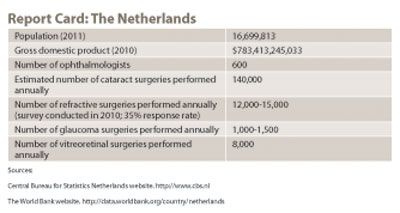Integrated eye care, task delegation key priorities in the Netherlands
Increased centralization and gradual technological investments are also important aspects of a new program.
 Saskia M. Imhof |
An efficient system of integrated eye care will help ophthalmology maintain high standards in the Netherlands, according to Saskia M. Imhof, MD, PhD, FEBOphth, president of the Dutch Ophthalmological Society, or NOG.
“At NOG, we have recently released a document where we set the basis for a new organization model based on controlled task delegation and inter-professional collaboration with optometrists and orthoptists. We have come out with a solid management plan that should help us meet future challenges and will help the Ministry of Health to develop a high-quality and cost-effective system,” Dr. Imhof said.
As elsewhere in the Western world, ophthalmologists in the Netherlands are facing a growing demand for services amid limited financial resources due to the economic downturn.
However, there is a consensus that cost-effective solutions that consolidate high quality, rather than cuts, are the way to deal with budget restrictions, Dr. Imhof said.
“First of all, [because] there are a number of different eye care professionals with different functions, we must make sure that patients go to the right specialist for the specific need they have. Ophthalmologists have come to understand that a controlled process of delegating tasks is the basic condition for effective eye care management,” she said.
Another way of optimizing services is by increasing the centralization of care, to ensure that patients go to the appropriate place for their specific needs.
“Our model is evolving toward a system in which we are going to have front office and back office ophthalmic care. Front office is the accessible, patient-friendly people who are qualified to provide high-quality ophthalmological care, while the back office will be the big hospitals and university hospitals where specialized care and specialized, complex surgery are provided,” Dr. Imhof said.
Technology role
It is also important to make sensible choices regarding investments in technology. Recent technological developments have been monumental, Dr. Imhof said, but there is no need to buy all new devices and products and use them immediately. Investments should be gradual and based on priority.
For example, the NOG has asked the national legal and medical authorities to approve and recommend the off-label use of Avastin (bevacizumab, Genentech) as first-line treatment for age-related macular degeneration, with Lucentis (ranibizumab, Genentech/Novartis) as a secondary option for non-responders. The approval has increased the possibility of delivering affordable anti-VEGF treatment while simultaneously shielding ophthalmologists from liability for off-label use of the drugs.
“Our cost-effectiveness plan should make ophthalmic care efficient, high-quality, available and [affordable]. In other words, we should be able to offer more, thus meeting the increasing demand, without spending more,” Dr. Imhof said.
 |
Small private sector
The Netherlands has a universal health care system, funded through compulsory private insurance. All citizens pay the same premium, which guarantees coverage for all basic services. Insurance companies can offer additional services at an extra cost.
Ophthalmic care is mainly provided in hospital settings and, to a smaller extent, in outpatient clinics that deal with less complex pathologies. Except in cases of trauma and other emergencies, patients must be referred to an ophthalmologist by their general practitioner.
“The Netherlands is a small country but densely populated. We are 600 ophthalmologists for 16.5 million people and manage to cover well the needs of our patients throughout the national territory. There are no problems of long waiting lists in our country,” Dr. Imhof said.
Of the total number of ophthalmologists, 350 are men and 250 are women, but the number of women in the profession is growing.
All ophthalmologists are also trained as surgeons. More than 90% of them work in the public sector. Income-related concerns grew in 2009 and 2010 due to pay cuts, but salary increases are expected in 2012. Dr. Imhof said that Dutch ophthalmologists are generally happy with their income. They have the option of supplementing it in private practice, but less than 10% do so.
The few fully private clinics that exist in the Netherlands focus on refractive surgery.
“Refractive surgery has grown over the past, but numbers have now stabilized,” Dr. Imhof said.
Most private clinics voluntarily submit to a quality control process by the NOG certifying that they comply with the standards of the European Registry of Quality Outcomes for Cataract and Refractive Surgery.
“Though not obligatory, this practice helps patients make an informed choice. It’s a guarantee that those doctors follow consensus guidelines and can be trusted for quality of care. It is also a good way for us to have a centralized control of private practices, their compliance to regulations and their outcomes,” Dr. Imhof said. – by Michela Cimberle

- Saskia M. Imhof, MD, PhD, FEBOphth, can be reached at Room E03.101, Heidelberglaan 100, 3584 CX, Utrecht, the Netherlands; +31-88-75-51683; email: s.m.imhof@umcutrecht.nl.
- Disclosure: Dr. Imhof has no relevant financial disclosures.
